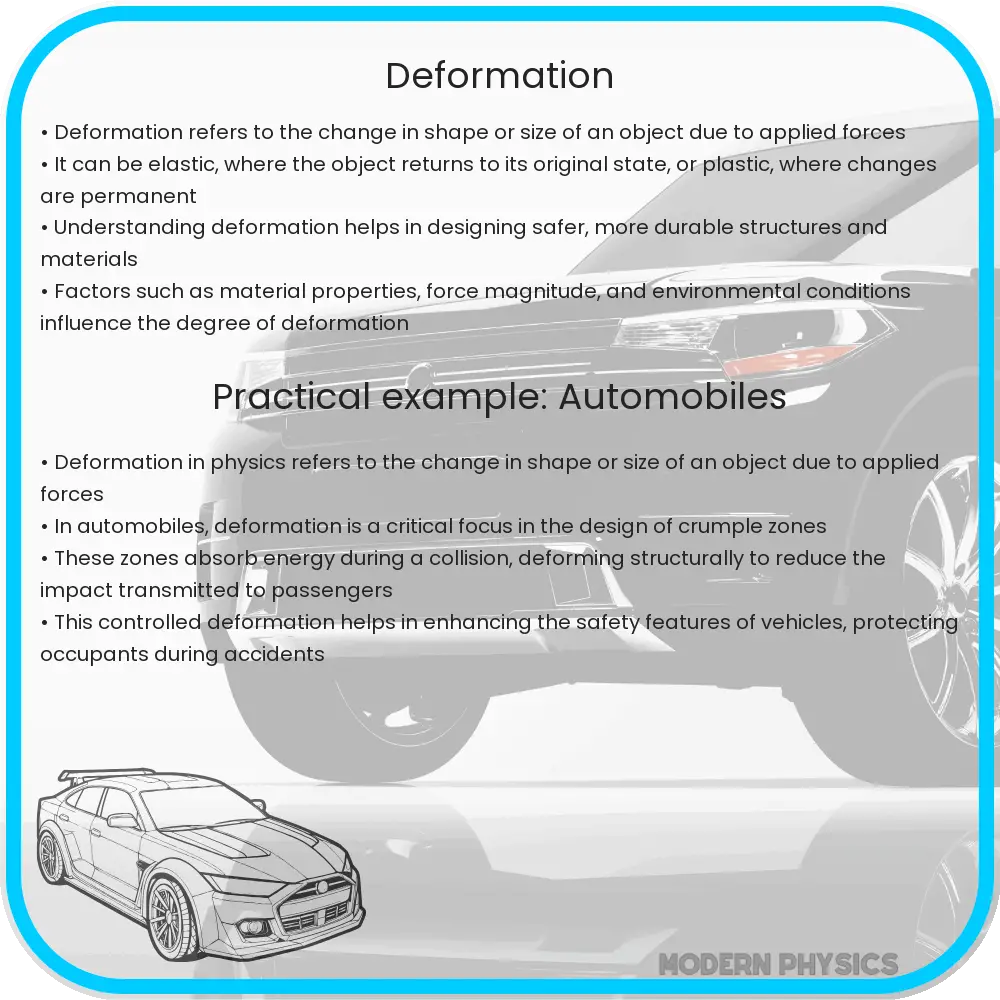Explore the essentials of deformation in dynamics, its properties, effects, and advanced analysis techniques shaping industries and innovation.

Understanding Deformation in Dynamics
Deformation in dynamics is a fundamental concept in the study of material science and structural engineering. It refers to the alteration of an object’s shape and size under the influence of external forces. This phenomenon is crucial in understanding how materials and structures behave under various conditions.
Properties of Deformation
Deformation is characterized by several key properties:
- Elasticity: This property describes the ability of a material to return to its original shape after the removal of the applied force. Materials like rubber exhibit high elasticity.
- Plasticity: In contrast to elasticity, plasticity refers to the permanent deformation of a material when subjected to a force beyond its yield strength. Metals like copper and aluminum demonstrate plastic behavior.
- Viscoelasticity: Some materials exhibit both viscous and elastic characteristics when deformed. This is known as viscoelasticity, commonly observed in polymers.
- Brittleness: Brittle materials, such as glass, experience very little or no plastic deformation before breaking.
Effects of Deformation
Deformation impacts materials and structures in several ways:
- Stress and Strain: Deformation leads to stress (force per unit area) and strain (deformation per unit length). Stress-strain curves help in understanding the material’s response to external forces.
- Failure Analysis: Understanding deformation allows engineers to predict and prevent material failure in structures.
- Material Properties: Deformation analysis is crucial in determining a material’s mechanical properties, such as tensile strength and ductility.
- Design and Safety: Accurate prediction of deformation behavior is vital for the safe and efficient design of structures and components.
Analysis of Deformation
The analysis of deformation involves several considerations:
- Computational methods like Finite Element Analysis (FEA) are widely used to simulate and predict deformation under various load conditions.
- Experimental techniques, such as tensile tests, provide empirical data to validate theoretical models.
- Chemical composition and microstructure of materials greatly influence their deformation characteristics.
For instance, the tensile strength of steel (\(Fe_3C\)) can be altered by varying the carbon content (\(C\)).
This analysis is crucial in industries ranging from aerospace to civil engineering, where understanding material behavior under dynamic conditions is essential for the safety and functionality of structures and devices.
Advanced Techniques in Deformation Analysis
Recent advancements in technology have significantly enhanced the analysis of deformation in materials. High-resolution imaging and digital image correlation techniques allow for precise measurement of strain distribution. Additionally, molecular dynamics simulations provide insights into deformation at the atomic level, particularly valuable in the field of nanotechnology.
Environmental and Temperature Effects
Environmental factors, particularly temperature, play a crucial role in material deformation. For example, metals exhibit increased ductility at higher temperatures, while polymers might become brittle at low temperatures. Understanding these effects is essential in designing materials for specific environmental conditions.
Impact on Industry and Innovation
The study of deformation in dynamics has profound implications across various industries. In automotive engineering, it leads to safer and more efficient vehicle designs. In construction, it aids in creating structures capable of withstanding earthquakes and other dynamic loads. In the field of biomedical engineering, understanding the deformation properties of biomaterials is crucial for designing implants and prosthetics.
Future Directions
Looking forward, the field is moving towards the development of materials with tailored deformation properties. Smart materials that can change their deformation characteristics in response to external stimuli, such as temperature or electric fields, are an area of growing interest. These materials hold promise for revolutionary applications in various sectors, including aerospace, automotive, and healthcare.
Conclusion
In conclusion, the study of deformation in dynamics is a multidisciplinary field that intersects material science, engineering, and physics. It is fundamental to understanding and predicting the behavior of materials under stress. The continuous evolution in this field, propelled by technological advancements and innovative research, is pivotal in developing safer, more durable, and efficient materials and structures. As we venture into an era of more complex and demanding engineering challenges, the role of deformation analysis will become increasingly critical, paving the way for new breakthroughs and applications that can transform our world.
